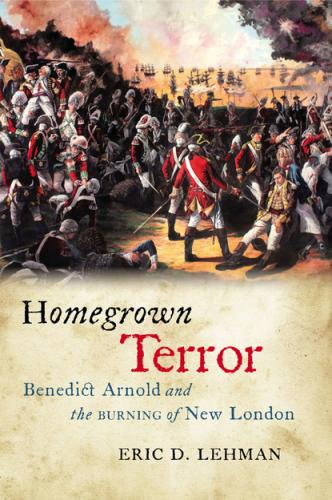Homegrown Terror. Eric D. Lehman
Washington’s chief intelligence officer, stating, “I opened a private correspondence with some persons in New York (for Gen Washington) which lasted through the war. How beneficial it was to the commander-in-chief is evidenced by his continuing the same to the close of the war. I kept one or more boats continually employed in crossing the Sound on this business.”6 In such understated remarks he was referring to taking charge of the network of spies that Washington was using, primarily in New York City.
Tallmadge’s career in the regular army is impressive, though not as impressive as Benedict Arnold’s. In June 1776 he joined the army in New York to wait for the British fleet and took part in those awful battles in which the overwhelming force of British redcoats pushed General Washington and the American brigades off Long Island, then off Manhattan, and back to the heights of Westchester County. He was promoted to captain in December of that year by George Washington himself, having been one of the few to have fought bravely throughout the terrible campaign. During that winter, while the exhausted army rested in New Jersey, he returned to Weathersfield to train a regiment of dragoons. In the spring of 1777, at the head of his regiment, he marched from Weathersfield all the way to Morristown, where he joined Washington in that season’s campaign. By July he had been promoted to major and became a field officer in the regiment. He took part in all the combat in Pennsylvania during that autumn, fighting at Brandywine and Germantown.7 As commander of his light dragoon company, Tallmadge was praised by Congress.8
But he began doing much more. While Washington and his men suffered at Valley Forge, Tallmadge and detachment of dragoons spent their time galloping around the no-man’s-land between the camp and Philadelphia, fighting off patrols of British light horses. This appears to have been largely cover for espionage work. On one occasion at least he rode to Germantown and met a female spy, who had ventured into Philadelphia on the pretense of selling eggs. As he was talking to her, a British patrol arrived, and he grabbed the woman and galloped with her for three miles before letting her off at a safe place.9
As the northern war settled into a standoff, he began his other work in earnest. By 1778 he corresponded with “Samuel Culper,” the name assumed by the two chief spies in New York, Abraham Woodhull and Robert Townsend, while his own code name was John Bolton or simply #721. He received constant intelligence as to British troop strength and position. They used invisible ink invented by John Jay’s brother James, and by 1779 Tallmadge was even using a cipher code similar to ones used by the British. Pocket dictionaries with this code were used by his spies to decode and encode messages.10 Meanwhile, he kept up an extensive correspondence with George Washington, keeping the commander in chief apprised of all the intelligence. Though not strictly written in code, this correspondence remained vague and indeterminate, with lines like “You will be pleased to observe the strictest silence with respect to ____ as you are to be the only person intrusted with the knowledge or conveyance of his letters.”11
He had a difficult job. The British had the best secret service in the world in the eighteenth century, with professionals who stuffed messages inside hollow silver bullets that could be swallowed if necessary. But no matter how good they were, spies still had a dangerous job. Israel Putnam caught one and wrote to the Tory governor of New York, William Tryon,
Sir—Nathan Palmer, a lieutenant in your service, was taken in my camp as a spy; he was tried as a spy; he was condemned as a spy; and you may rest assured, sir, he shall be hanged as a spy.
I have the honor to be, &/C.
ISRAEL PUTNAM.
P. S. Afternoon. He is hanged.12
Luckily for the British, they also had a ready-made spy network in the colonies—the Loyalists. Of course, there was no neat and tidy separation between Loyalists and Revolutionaries. There were conservative Whig-Loyalists who tried to maintain power through the representative government that they nevertheless supported. There were religious neutrals, such as the Quakers, who supported the Revolution but did not participate. There were “rationalists” like the clergy who did not like the Calvinist leadership of the Revolution and could come down on either side, or neither. There were those who sympathized with the “Whig principles” of the Revolution but remained loyal to England, and so on.13 However useful these political and religious distinctions are, we could also separate the people of the time into two different camps: those who saw America as their home and tried to do what they thought was right to preserve that home and those who were more concerned with self-preservation.
Конец ознакомительного фрагмента.
Текст предоставлен ООО «ЛитРес».
Прочитайте эту книгу целиком, купив полную легальную версию на ЛитРес.
Безопасно оплатить книгу можно банковской картой Visa, MasterCard, Maestro, со счета мобильного телефона, с платежного терминала, в салоне МТС или Связной, через PayPal, WebMoney, Яндекс.Деньги, QIWI Кошелек, бонусными картами или другим удобным Вам способом.
